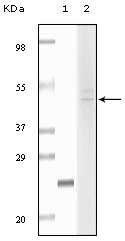Fibulin-5 Monoclonal Antibody
- 货号:YM0272
- 应用:WB;IHC;IF;ELISA
- 种属:Human
- 免疫原:
- Purified recombinant fragment of Fibulin-5 expressed in E. Coli.
- 特异性:
- Fibulin-5 Monoclonal Antibody detects endogenous levels of Fibulin-5 protein.
- 组成:
- Liquid in PBS containing 50% glycerol, 0.5% BSA and 0.02% sodium azide.
- 稀释:
- WB 1:500 - 1:2000. IHC 1:200 - 1:1000. ELISA: 1:10000.. IF 1:50-200
- 纯化工艺:
- Affinity purification
- 储存:
- -15°C to -25°C/1 year(Do not lower than -25°C)
- 其他名称:
- FBLN5;DANCE;Fibulin-5;FIBL-5;Developmental arteries and neural crest EGF-like protein;Dance;Urine p50 protein;UP50
- 背景:
- The protein encoded by this gene is a secreted, extracellular matrix protein containing an Arg-Gly-Asp (RGD) motif and calcium-binding EGF-like domains. It promotes adhesion of endothelial cells through interaction of integrins and the RGD motif. It is prominently expressed in developing arteries but less so in adult vessels. However, its expression is reinduced in balloon-injured vessels and atherosclerotic lesions, notably in intimal vascular smooth muscle cells and endothelial cells. Therefore, the protein encoded by this gene may play a role in vascular development and remodeling. Defects in this gene are a cause of autosomal dominant cutis laxa, autosomal recessive cutis laxa type I (CL type I), and age-related macular degeneration type 3 (ARMD3). [provided by RefSeq, Jul 2008],
- 功能:
- disease:Defects in FBLN5 are a cause of autosomal dominant cutis laxa [MIM:123700]. Hereditary cutis laxa refers to a heterogeneous group of connective tissue disorders characterized by cutaneous abnormalities and variable systemic manifestations. The most constant clinical feature is loose skin, sagging over the face and trunk. Hereditary cutis laxa is inherited in both autosomal dominant and autosomal recessive modes. Autosomal dominant cutis laxa is a relatively benign inherited and acquired connective tissue disorder.,disease:Defects in FBLN5 are a cause of autosomal recessive cutis laxa type I (CL type I) [MIM:219100]. CL type I shows the most severe phenotype and has the poorest prognosis. In addition to the skin, internal organs enriched in elastic fibers, such as the lung and arteries, are affected.,disease:Defects in FBLN5 are the cause of age-related macular degeneration type 3
- 细胞定位:
- Secreted . Secreted, extracellular space, extracellular matrix . co-localizes with ELN in elastic fibers. .
- 组织表达:
- Expressed in skin fibroblasts (at protein level)(PubMed:17035250). Expressed predominantly in heart, ovary, and colon but also in kidney, pancreas, testis, lung and placenta. Not detectable in brain, liver, thymus, prostate, or peripheral blood leukocytes (PubMed:10428823).

- Western Blot analysis using Fibulin-5 Monoclonal Antibody against truncated fibulin5 recombinant protein (1) and HeLa cell lysate (2).

- Immunohistochemistry analysis of paraffin-embedded human stomach carcinoma (left) and breast carcinoma (right), showing cytoplasmic localization with DAB staining using Fibulin-5 Monoclonal Antibody.





